Plant Vogtle Units 3 and 4 Win POWER's Plant of the Year Award
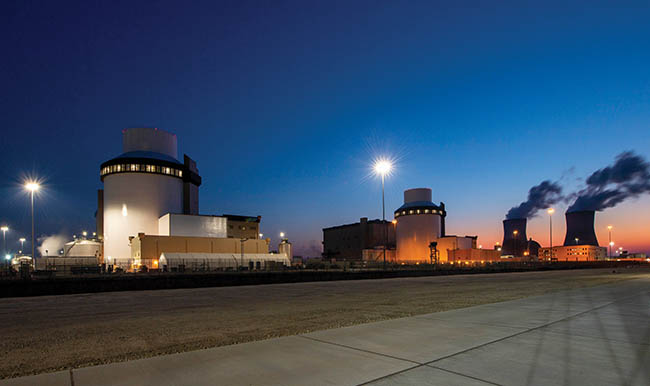
Adding new reactors to the U.S.’s fleet of nuclear power plants doesn’t happen every day. In fact, prior to the addition of Plant Vogtle Units 3 and 4, it hadn’t been done from scratch in decades. Success was not easy, but perseverance paid off as Georgia Power now operates the largest thermal power plant in the country at Plant Vogtle.
Nuclear energy plays a very important role in Georgia’s energy portfolio. Georgia Power began operating a reactor in the state in 1975 when the first unit at Plant Hatch entered commercial operation near Baxley, Georgia. A second unit was added at Hatch in 1979, two units entered service at the Vogtle Electric Generating Plant near Waynesboro, Georgia, in 1987 and 1989, and today about 25% of the state’s electricity is supplied by nuclear power.
Plant Vogtle is named for Alvin W. Vogtle Jr., past Chairman of the Board of Southern Company and an executive leader with the company from the 1960s to the 1980s. Prior to his career with Southern Company, Vogtle was a storied World War II veteran. He was captured by the Germans and made a prisoner of war. During 26 months of confinement, he tried to escape on six separate occasions, scaling a 15-foot-high barbed-wire fence, and crossing the Rhine River to Switzerland and freedom on the final attempt.
The Need for More Reactors
Georgia Power said the journey of Vogtle Units 3 and 4 really started with the completion of Vogtle Units 1 and 2, and the safe and highly reliable operation of those units from commissioning to today. “The clean, safe, reliable, and affordable energy those units provide to Georgia were foundational elements for building Vogtle 3 and 4, the first new nuclear reactors to come online in more than 30 years,” Aaron Abramovitz, executive vice president and Chief Financial Officer for Georgia Power, told POWER.
Yet, while the addition of the units may have been in the cards for decades, the real work commenced in 2004. That’s when Southern Company, the parent of Georgia Power, began considering the feasibility of new nuclear units. Southern Company was one of the charter members of NuStart LLC, formed that year to combine industry resources and pursue federal cost sharing for the advancement of Westinghouse’s AP1000, a pressurized-water reactor (PWR, Figure 1), and GE Hitachi’s Economic Simplified Boiling-Water Reactor (ESBWR) designs. NuStart was also instrumental in the preparation of a reference combined construction and operating license application for the AP1000.
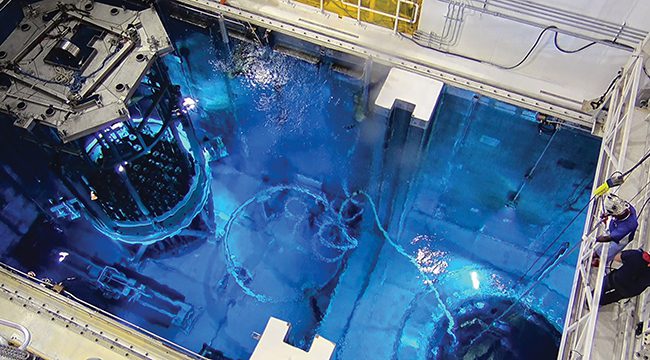 |
|
1. This image shows fuel loading activities in progress on the Vogtle Unit 4 AP1000 pressurized water reactor. Courtesy: Georgia Power Company |
Meanwhile, Southern Company also began to evaluate various sites for a dual-unit addition. The Vogtle site was selected with Georgia Power as the lead sponsor of the project within Southern Company. Discussions with co-owners of the existing units, which are split between Georgia Power (45.7%), Oglethorpe Power (30%), the Municipal Electric Authority of Georgia (MEAG Power, 22.7%), and Dalton Utilities (1.6%), began almost immediately.
A Long and Winding Road
The co-owners entered into an agreement to explore development of two new nuclear units on the Vogtle site in 2005. Southern Nuclear, the Southern Company subsidiary that operates the company’s nuclear units, quickly began work on an application for an Early Site Permit for Vogtle Units 3 and 4. The application was submitted to the U.S. Nuclear Regulatory Commission (NRC) in 2006.
Meanwhile, the co-owners entered into a Participation Agreement to pursue construction of the units and determine each party’s ownership interest, which was ultimately distributed similarly to Units 1 and 2. Negotiations also started with a consortium comprised of Westinghouse Electric Co. and Shaw-Stone & Webster on an engineering, procurement, and construction (EPC) contract to deliver two AP1000 units. Southern Nuclear applied for a Limited Work Authorization with the NRC the following year.
The need for new nuclear generation was confirmed in 2007 through Georgia Power’s Integrated Resource Plan (IRP) process with the Georgia Public Service Commission (PSC), Abramovitz explained. “This regular process brings many stakeholders together to evaluate and discuss Georgia’s future energy needs and how to best meet new demand,” he said.
The co-owners, Westinghouse, and Shaw-Stone & Webster executed an EPC agreement in 2008 to deliver the additional Vogtle units based on the Westinghouse AP1000 design. Southern Nuclear applied to the NRC for a Combined License, referencing the still-pending Early Site Permit and the AP1000 certified design, which was undergoing amendments requested by Westinghouse at the time of filing.
In 2009, the NRC issued the Early Site Permit and Limited Work Authorization, which permitted limited safety-related site work to begin in advance of the issuance of the Combined Licenses for Vogtle Units 3 and 4. The Georgia PSC also approved construction of the new units that year and excavation commenced at the site.
The NRC finally issued the Combined License for the Vogtle 3 and 4 reactors in 2012, which cleared the way for safety-related civil construction to begin. 2012 was also the year in which the first of what would be a few contractor shakeups took place. In this case, CB&I (originally known as Chicago Bridge & Iron Co.) acquired Stone & Webster and replaced The Shaw Group as the constructor under the EPC agreement. A few years later, Westinghouse, which was a group company of Toshiba Corp., signed a definitive agreement to acquire CB&I Stone & Webster Inc., the nuclear construction and integrated services businesses of CB&I. Westinghouse then entered into an agreement with Fluor Corp. to manage a significant portion of the construction for the Vogtle project.
Fluor’s involvement would last less than two years, however. Westinghouse ended up filing for bankruptcy protection in 2017, which led to Georgia Power assuming direct control over the project as agent for the co-owners. Southern Nuclear managed the project for Georgia Power and contracted with Bechtel to complete construction of the units and with Westinghouse to continue to provide engineering and design services.
Trials and Tribulations
The challenges in licensing and constructing the first new nuclear plants in the U.S. in more than three decades, based on a first-of-a-kind design (Figure 2), were many and varied. Perhaps the biggest challenge was that the nuclear construction infrastructure in the U.S. (and to some extent around the world) had been allowed to deteriorate during the 1980s and 1990s to the point where it had to be rebuilt. Supply chains had to be re-established and workers had to be trained to do nuclear-quality work that is far more precise and exacting than typical industrial work.
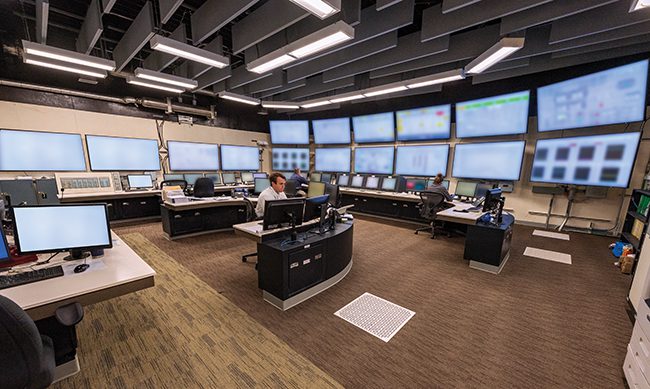 |
|
2. Vogtle Unit 4’s main control room is shown here. The technology incorporated into Units 3 and 4 is vastly different from what was installed in Vogtle Units 1 and 2 in the 1980s. Courtesy: Georgia Power Company |
“When we look back over the entire project, there are certainly many challenges to reference,” John Williams, senior vice president for Vogtle 3 and 4, told POWER. “We are proud that we faced each of these challenges head on—in partnership with our co-owners, the Georgia PSC, and labor partners. This continued alignment and clear communication between all parties was essential to our ability to complete the project.”
The initial contractual arrangement with Westinghouse and Shaw-Stone & Webster was essentially a firm price/guaranteed schedule EPC agreement. Under this arrangement Southern Nuclear, as the licensed constructor, provided management oversight to the EPC contractor, which directed day-to-day construction activities. After Westinghouse rejected the EPC agreement in its bankruptcy proceeding, Southern Nuclear took a more direct role in managing Bechtel’s construction activities. Bechtel directly managed craft labor, and means and methods of construction, with oversight by Southern Nuclear.
Fairly early in the project, in 2011, a tsunami struck the Fukushima Daiichi nuclear plant in Japan, further complicating things. After a several-month delay, during which the NRC assessed the safety of the AP1000 design under Fukushima-like event conditions, Revision 19 to the AP1000 Design Control Document was certified by the NRC.
Finally, the COVID-19 pandemic delivered unprecedented challenges. “We worked hard to ensure that the people coming on-site were informed and knew that their safety was the most important element of construction,” Williams said.
A Safe and Productive Workforce
Prior to the pandemic, the workforce peaked at approximately 9,000 workers. “However, if you consider additional support personnel and project managers, that number reaches 10,000,” said Williams. “In all, we estimate approximately 35,000 different individuals were badged for the site in various roles throughout the project. In addition to the construction jobs, the new units are providing 800 full-time jobs across all functions.”
Notably, the Vogtle expansion project had a continuous run of more than 71 million man-hours without a lost time incident (Figure 3), which set a record for Bechtel for a U.S. construction project. Furthermore, hundreds of millions of man-hours were worked throughout the project with very respectable safety metrics overall.
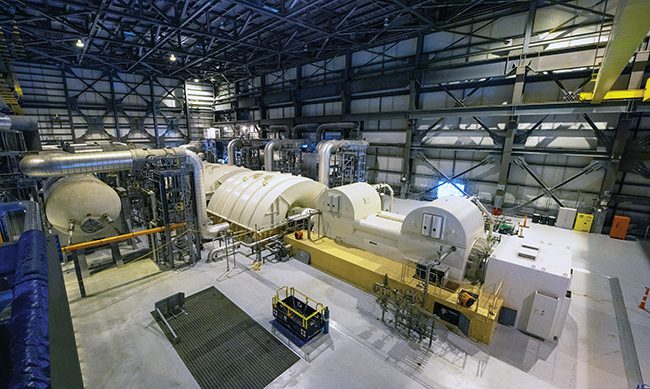 |
|
3. Vogtle Unit 3’s turbine generator is shown here. A focus on safety was important when installing this massive equipment. Courtesy: Georgia Power Company |
“Safety is the top value for our company,” Williams said. “The project’s safety record was well below the OSHA [Occupational Safety and Health Administration] heavy construction industry recordable incident rate averages, and there were no fatalities during the construction.”
Environmental Stewardship
Georgia Power’s first president, Preston Arkwright, reportedly coined the phrase: “A Citizen wherever we serve.” The company said this statement underscores its commitment to making the communities it is privileged to serve, better because Georgia Power is there. “That commitment permeates every part of our business, including our generation facilities,” Abramovitz noted.
The Plant Vogtle site is located adjacent to the Savannah River, which provides access to fresh water (Figure 4) and an environment that is home to many species of flora and fauna. Since 1993, Plant Vogtle has been recognized as a Certified Wildlife Habitat by the Wildlife Habitat Council. The site is situated on approximately 3,000 acres, with hundreds of those acres replanted with native loblolly and longleaf pines.
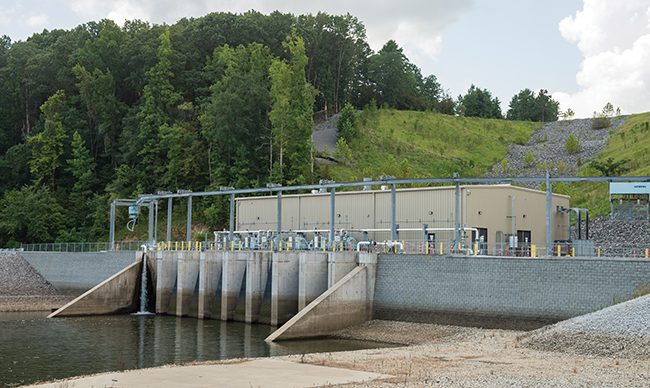 |
|
4. Plant Vogtle is located adjacent to the Savannah River. The river water intake structure for Units 3 and 4 is shown here. Courtesy: Georgia Power Company |
“Every day, across our facilities, we work to minimize the impact of our operations on the environment and protect our state’s natural resources,” said Abramovitz. Among its proactive measures, Plant Vogtle has management programs that enhance the habitat for species such as bluebirds, wood ducks, wild turkey, and the endangered red-cockaded woodpecker. “One particular example we’re proud of is our continued partnership with the Georgia Department of Natural Resources and U.S. Fish and Wildlife Service to be part of the Gopher Tortoise Candidate Conservation Agreement with Assurances (CCAA) program,” Abramovitz said.
A Focus on Customers
From the beginning, Georgia Power said the Vogtle 3 and 4 co-owners have worked to minimize the impact of the project to customers and their power bills. The first example of this effort was negotiating essentially a firm-price contract for the units.
“Under this contract, the company only paid for completed engineering, procurement, or construction milestones, thereby protecting customers from potential cost increases during the initial stages,” Abramovitz explained. “The EPC agreement also included a performance guarantee from Toshiba—Westinghouse’s parent company—which the company and co-owners called upon following Westinghouse’s bankruptcy in 2017.”
To further mitigate costs for customers, Georgia Power proactively pursued federal incentives, such as production tax credits (PTCs), which were introduced in the 2005 Energy Act and extended in the 2017 Tax Cuts and Jobs Act. “PTCs are expected to lower operations costs, saving our co-owners’ members and Georgia Power customers several billions of dollars over the first eight years of operations,” said Abramovitz. The project also pursued and secured nearly $12 billion in loan guarantees from the U.S. Department of Energy, which is estimated to save customers across Georgia hundreds of millions of dollars in financing costs.
Having a strong contract from the outset also benefited the co-owners and their customers. “The capital construction costs for all co-owners was approximately $21 billion, net of nearly $4 billion the co-owners received from the Toshiba Parent Guarantee following the bankruptcy of Westinghouse,” Abramovitz reported. “This represents the total capital cost to the owners to build the two new AP1000 units and the common facilities which support them both.”
AP1000 a Solid Design Choice
Georgia Power evaluated various nuclear reactor plant technologies for the Vogtle expansion project. Designs considered included the AP1000, ESBWR, General Electric’s Advanced Boiling Water Reactor (ABWR), and AREVA’s Evolutionary Power Reactor (EPR). An interdisciplinary group within Georgia Power and Southern Company conducted a technical evaluation that considered the then-current state of design and engineering, and regulatory approvals of the various technologies.
The group ultimately concluded that the AP1000 was the preferred choice. Several factors led to the selection. One positive aspect was Southern Company’s familiarity with Westinghouse’s pressurized water nuclear steam supply system (NSSS). The NSSS technology is utilized at both Vogtle Units 1 and 2, as well as units at Alabama Power’s Plant Farley, another Southern Company dual-unit site. Another driving factor was the AP1000’s unique passive cooling system (Figure 5), which provides up to 72 hours of emergency cooling in the unlikely situation that all offsite power is lost. The AP1000 had additional safety advantages over some of the other designs as well.
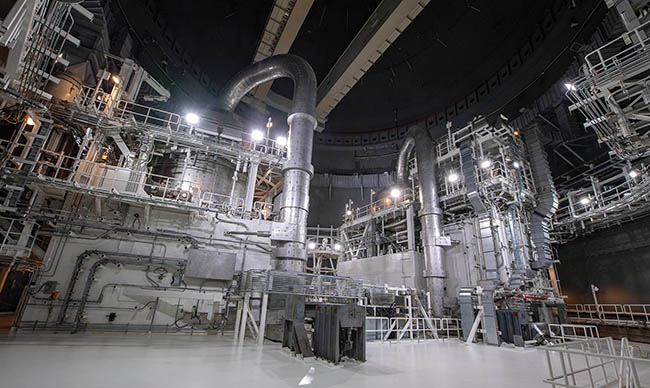 |
|
5. A look inside the Vogtle Unit 4 containment. The AP1000 design includes passive cooling systems and other features that make it even safer than previous pressurized-water reactor designs. Courtesy: Georgia Power Company |
The fact that the NRC had already certified an earlier version of the AP1000 design at the time of the selection didn’t hurt. Meanwhile, Westinghouse was actively pursuing construction contracts to build the AP1000, both domestically and internationally, so the co-owners saw signs that the design would be well-supported throughout the industry. Lastly, Georgia Power, as agent for the co-owners, was able to negotiate favorable terms and conditions in an EPC agreement with the consortium, making the AP1000 a sound selection.
Notably, other AP1000 projects also moved forward. Two units were ordered in South Carolina for construction at the V.C. Summer nuclear site and four units were ordered in China—two for the Sanmen power station and two for the Haiyang facility. While the V.C. Summer expansion was ultimately abandoned after several years of work, the Sanmen project was completed while the Vogtle expansion was in progress, which provided a number of benefits for the construction and commissioning teams.
“Through a lessons learned sharing agreement with Sanmen Nuclear Power in China, we were able to get hands-on testing experience on their AP1000 units while also sharing our world-class safety, nuclear operations, chemistry, and maintenance programs,” Williams said. “Our most significant lessons learned were related to first-of-a-kind testing requirements for the AP1000 that were performed in China, which, as a result, were not required to be performed again at the Vogtle site. Vogtle engineers and operators were also allowed to witness startup testing and commissioning of the Chinese units and bring that experience to the startup testing and commissioning of the Vogtle units.”
Constructing a dual-unit project at Plant Vogtle provided benefits of its own. Specifically, teams were able to incorporate lessons learned from Unit 3 to make the completion of construction, testing, and startup on Unit 4 more efficient.
“There is no question that lessons learned in the areas of project management, quality assurance and control, testing, and the state of the detailed design would greatly benefit future AP1000 projects,” said Williams. “We hope that others can benefit from the Vogtle project, and we are committed to sharing lessons learned and best practices with other companies pursuing new nuclear. We regularly host visitors from around the world at the site, and conversations are continuing today,” he added.
Bringing the Project to Completion
Vogtle Unit 3 entered commercial operation on July 31, 2023. Unit 4 entered commercial operation on April 29, 2024. “The completion of Vogtle 3 and 4 took perseverance, courage, cooperation, trust, and a lot of hard work,” said Abramovitz. “Along with our team from across Southern Company, Georgia Power, and Southern Nuclear, success on this historic project required the hard work and dedication of tens of thousands of American craft workers and engineers, a committed group of co-owners, and regulators who had the courage to support new nuclear when others did not. It took a lot of hard work locally, and valuable collaboration and support among so many, including the federal government.”
And the proof is in the pudding. “Vogtle Unit 3’s initial performance has exceeded our expectations,” stated Williams. “Since it began commercial operation in July 2023, Unit 3 has operated at greater than 98% capacity factor, running at 100% since commercial operation was declared with the exception of a planned five-day maintenance outage.”
Typical industry average capacity factors are approximately 93%—and that’s for units that have been online for decades. Williams said the excellent operation of Unit 3 demonstrates the priority that Southern Nuclear placed on safety and quality during the construction of the units. “We’re looking forward to Unit 4 joining Unit 3 in its record of superior performance to date,” he said.
The two new reactors bring Plant Vogtle’s total generating capacity to nearly 5 GW, making Vogtle’s four units the largest nuclear power plant (Figure 6) in the U.S. “When you consider the timeline and scale of the project, and the challenges we overcame, it’s truly a monumental accomplishment,” Abramovitz concluded.
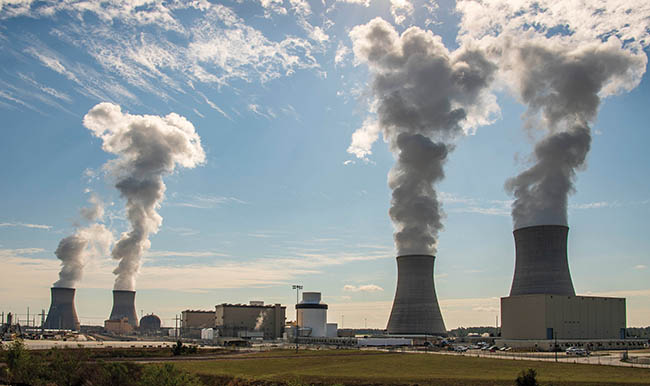 |
|
6. With four reactor units in commercial operation and a total capacity of nearly 5 GW, Plant Vogtle is the largest nuclear power plant in the U.S. Courtesy: Georgia Power Company |
POWER couldn’t agree more. In recognition of the great work carried out by Southern Company and the entire team involved in the Plant Vogtle expansion, POWER presents its 2024 Plant of the Year award to Plant Vogtle Units 3 and 4. Congratulations!
—Aaron Larson is POWER’s executive editor.